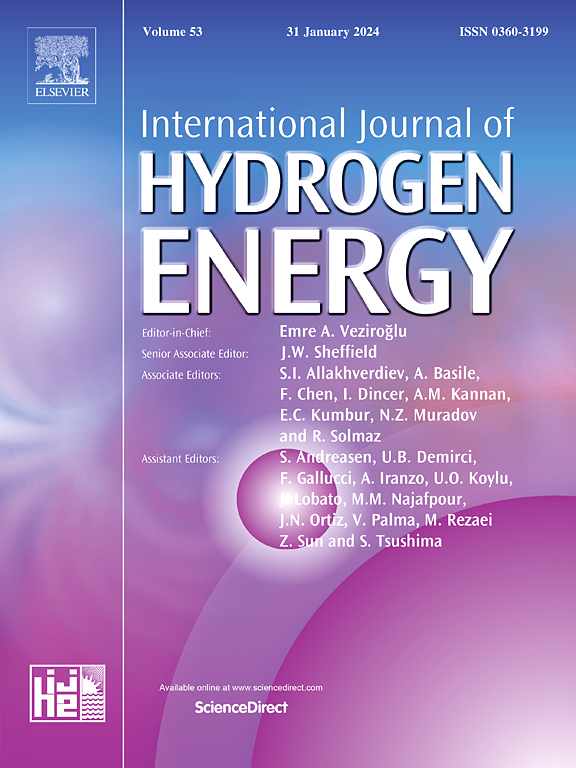氢化镁中尺寸依赖的纳米约束效应
IF 8.1
2区 工程技术
Q1 CHEMISTRY, PHYSICAL
引用次数: 0
摘要
纳米约束效应是改善MgH2脱氢动力学的关键。然而,碳基载体对MgH2纳米颗粒的纳米约束作用的微观机制仍然不明确,这阻碍了碳基纳米限制MgH2纳米颗粒的设计。为了解决这一难题,我们应用密度泛函理论(DFT)计算来研究碳基载体与MgH2纳米颗粒之间的相互作用。为了分析这一问题,我们设计了多种碳纳米管纳米限制MgH2纳米颗粒体系,粒径/孔径比范围为0.3 ~ 0.8。碳基载体与MgH2纳米颗粒的相互作用强度随着粒径/孔径比的增大而逐渐增大,脱氢温度随着粒径/孔径比的增大而降低。碳基载体的电子会转移到MgH2纳米粒子上,导致Mg-H键的减弱。Mg-H键越弱,脱氢势垒越低,这与计算和实验中脱氢温度与粒径/孔径比成反比的现象一致。本研究不仅从微观角度阐明了纳米限制对MgH2的影响,而且为碳基纳米限制MgH2纳米颗粒的设计和开发提供了理论依据。本文章由计算机程序翻译,如有差异,请以英文原文为准。
Size-dependent nanoconfinement effects in magnesium hydride
Nanoconfinement effect is crucial to improve the dehydrogenation kinetics of MgH2. However, the underlying micro-mechanism for nanoconfinement effect of carbon-based carrier on MgH2 nanoparticles is still ambiguous, hindering the design of carbon-based nanoconfined MgH2 nanoparticles. To address this dilemma, we applied density functional theory (DFT) calculations to investigate the interaction between carbon-based carrier and MgH2 nanoparticles. To analyze this issue, we designed various systems of carbon nanotubes nanoconfined MgH2 nanoparticles, with the range of particle size/pore size ratio from 0.3 to 0.8. The interaction strength between carbon-based carrier and MgH2 nanoparticles gradually increases with the increase of particle size/pore size ratio, and the dehydrogenation temperature decreases with the increase of particle size/pore size ratio. The electron of carbon-based carrier will transfer to MgH2 nanoparticles, leading to the weakening of Mg–H bonds. The weakened Mg–H bonds corresponding to lower dehydrogenation barrier, which is consistent with the phenomenon that the dehydrogenation temperature is inversely proportional to particle size/pore size ratio in calculations and experiments. This work not only elucidates the size-dependent nanoconfinement effects on MgH2 from a microscopic perspective, but also provides the theoretical basis for the design and development of carbon-based nanoconfined MgH2 nanoparticles.
求助全文
通过发布文献求助,成功后即可免费获取论文全文。
去求助
来源期刊

International Journal of Hydrogen Energy
工程技术-环境科学
CiteScore
13.50
自引率
25.00%
发文量
3502
审稿时长
60 days
期刊介绍:
The objective of the International Journal of Hydrogen Energy is to facilitate the exchange of new ideas, technological advancements, and research findings in the field of Hydrogen Energy among scientists and engineers worldwide. This journal showcases original research, both analytical and experimental, covering various aspects of Hydrogen Energy. These include production, storage, transmission, utilization, enabling technologies, environmental impact, economic considerations, and global perspectives on hydrogen and its carriers such as NH3, CH4, alcohols, etc.
The utilization aspect encompasses various methods such as thermochemical (combustion), photochemical, electrochemical (fuel cells), and nuclear conversion of hydrogen, hydrogen isotopes, and hydrogen carriers into thermal, mechanical, and electrical energies. The applications of these energies can be found in transportation (including aerospace), industrial, commercial, and residential sectors.
 求助内容:
求助内容: 应助结果提醒方式:
应助结果提醒方式:


